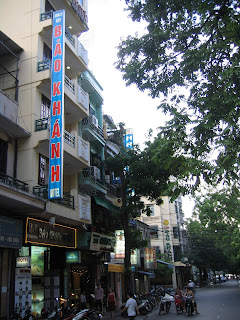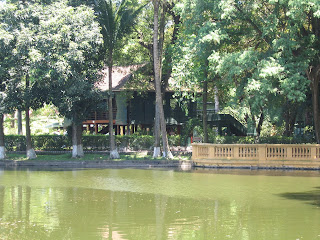Our trip to Halong Bay began unpleasantly--a bumpy, early-morning minibus ride through Vietnam's industrial heartland and then a long wait at a dock with dozens of wooden boats (junks) and hundreds of eager tourists. Our boat was a mini-cruise ship, complete with a sundeck, a dining room, outdoor lounge, and bedrooms. I'm almost surprised it didn't have wate-volleball competitions or babysitters for kids.

The dock at the mainland port of Halong

Waiting for the boat to leave. Desaix (left) and Ray, the PAW correspondent
As we headed out toward the jagged coastline in the distance, the boat staff brought out an amazing lunch beginning with succulent shrimp and enormous red crabs. That was followed by fish, squid, rice and cabbage. It was the kind of lunch you would expect to have on the way to one of the most beautiful places in the world.
Once everyone had their fill of seafood, we resettled on the upper sun-deck, resting in wooden seats, reading novels and taking in the scene. We reached the archipelago just as the sun was coming out, shining a bright haze onto the green cliffs. The islands were immense shafts of limestone which poked out of the sea like broken posts of a washed away pier. Each new inlet, each new cove brought new piles of rock that were even more unlikely than the last.


Left to right: Susan, Mark, Dierdre, Me, Elias, Dzung

We drifted for hours among the uninhabited cliffs, seemingly without any purpose, although we were all well aware that the end of the day would bring swimming. At about 4pm, we entered a cove that looked like the type of place Carribbean pirates would have gathered. And then we explored a cave where they would have hidden their treasure. The cave cut into the side of one of the limestone cliffs, one chamber extending deep into the island, big enough to be a convention center. Its walls were standard cave fare--enormous stalactytes and stalagmites lighted by eerie filtered light. And of course there was graffiti, names like Jean-Marie Devault, dated 1907. More unusually, however, the ceiling was an unusual surface of gentle, geometric white stone that reminded me of Butler's ceilings.


The view from the cave
The climb up to the cave left everyone drenched in sweat and even the crisp air inside the cave was little relief from the tropical heat. By the time we walked back down to the dock, we demanded in no uncertain terms that we go swimming. The crew obliged and stalled us in an open area. As soon as the engine stopped, we all leaped off the upper deck into the warm water. For more than an hour we jumped, each time trying to outdo ourselves with various airial maneuvers and synchronized diving. It was intensely fun, as good as any summer afternoon as a kid. And the setting, was, well, world class.
Gradually, the sun ducked behind an island and warm breezes pushed tropical storm clouds our way, where they dumped rain on us before setting off in the distance. The sky turned into a brilliant watercolor painting as we ate an Vietnamese dinner. By the time we all reconviened on the upperdeck, it was dark but the moon lit up the clouds above the islands. We stared out lazily, drinking Halida beers and sharing our views about the Iraq War and how America should be fighting terror. Our arguments were now heavily influenced by the Vietnam War. We were, after all, in Vietnam, floating in the Gulf of Tonkin.


One by one the group diminished as people headed below deck to sleep off a day of sun and jumping off boats. Finally, it was down to a handful, one claiming that there was bound to be a nuclear attack on America in the next ten years, the other arguing that total war will one day be necessary in the Middle East. It was a gloomy discussion. But I was on a boat, about to fall asleep in Halong Bay, and it was impossible for me feel worried.





































